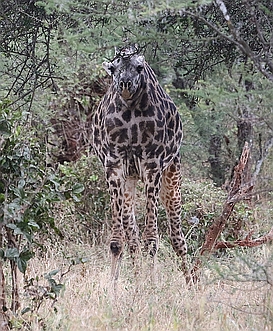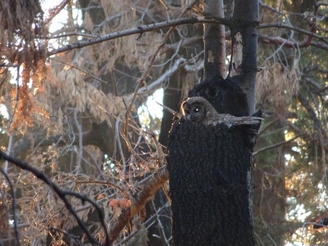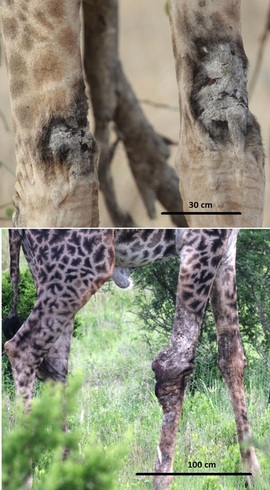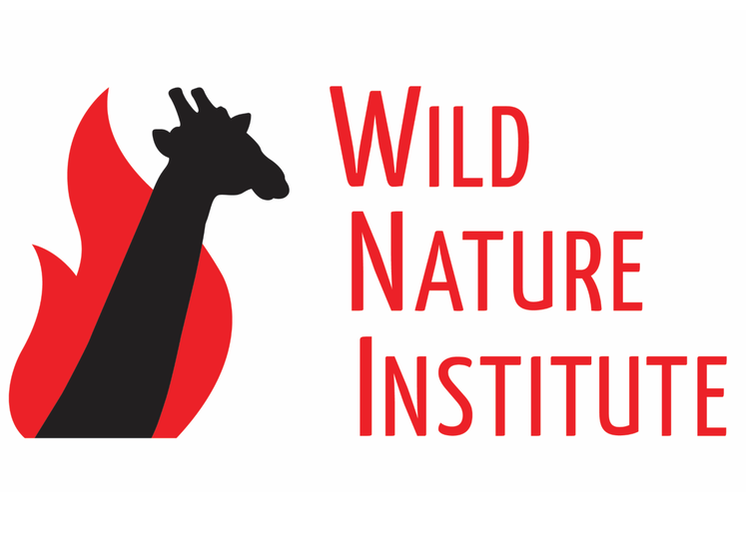 This Masai Giraffe appears to have no neck! But don’t worry – it’s all an illusion caused by the animal ducking under a tree. The pictures were taken by wildlife biologist Dr Derek Lee, at Tarangire National Park in northern Tanzania during a seasonal survey to document the births, deaths and movements of Masai giraffes. Dr Lee, 45, who works for the Wild Nature Institute, said: ‘At first, I was amazed and confused by this apparently neckless giraffe! ‘But then I realised she was ducking to look at us under the tree branch, and it was an optical illusion caused by foreshortening. ‘My wife fell out of her seat laughing when she saw it!’ But he also had something serious to say about the future of the animals. He added: ‘A giraffe without a neck is as unthinkable as a world without giraffes, but that’s where we are heading. ‘They are quietly going extinct along with elephants and rhino – the only three huge land animals to survive from the Pleistocene era, when there were lots of huge animals all over the world.’ Read more: http://metro.co.uk/2016/06/27/cheeky-giraffe-cant-wind-her-neck-in-because-she-doesnt-appear-to-have-one-5969172/#ixzz4CnAjvbgP
0 Comments
 Spotted Owl nest in severely burned southern California forest, San Bernardino Mountains. Photo by Rachel Fazio. Spotted Owl nest in severely burned southern California forest, San Bernardino Mountains. Photo by Rachel Fazio. New research on the California spotted owl has found that severely burned forests that have not been post-fire salvage logged are used by the threatened raptor when foraging for their small mammal prey. Stand-replacing fires, also called crown fires or high-intensity fires, do not harm spotted owl foraging habitat. "We looked at spotted owl foraging behavior at multiple spatial extents and we found that whatever scale we used, the owls foraged in severely burned unlogged forests in proportion to their availability. In other words, they foraged in burned forest with the same likelihood as in unburned forest." said Monica Bond, lead author of the study. Wildfires over the past two decades have affected southern California spotted owl habitat to a greater extent than elsewhere in the range of the subspecies. From 2003 to 2007, spotted owl territories in the region were especially affected by wildfire, with more than 40% of 168 breeding sites in the San Bernardino and San Jacinto mountains experiencing at least one fire. "These frequent and hot fires make southern California forests a good indicator of what may happen in more northerly forests of California in a warming climate," said Bond. "Luckily, forests burned by high-severity fire can still be considered suitable foraging habitat for California spotted owls." Bond continued, "We also found these spotted owls strongly selected foraging sites close to streambeds, so we recommend implementing protective measures and management activities that conserve water and streamside forests." The study was published this week by scientists from the Wild Nature Institute and the Center for Biological Diversity in the Journal of Wildlife Management, a peer-reviewed scientific journal for professional wildlife biologists. This is the latest in a series of scientific papers that have documented how resilient spotted owls are to high-severity fires, including so-called megafires. Spotted owl pairs have been shown to survive and continue to reproduce in breeding sites that experienced severe fire, even megafire, with success that is the same or higher than unburned sites. Spotted owls have also shown a significant preference for foraging in severely burned forest patches in the Sierra Nevada. However, post-fire salvage logging, also called forest restoration by the US Forest Service, causes site abandonment and reduces survival. Logging in an attempt to reduce the risk of fire, often called thinning or fuels reduction, also has adverse effects on spotted owls. The only studies that claimed forest fires hurt spotted owls have had logging in large portions of the study area. "It's high time we stopped managing our forests with the futile and unnecessary goal of stopping severe fires. All the science from the field says fuel buildup and insects don't make forest fires worse. It is extreme weather like the Santa Anna winds in southern California that push fires to become very large, but we will never be able to stop these weather-driven blazes, so we should not risk our firefighter's lives out in the wildlands. Instead, we should repurpose the billions of dollars we waste each year fighting wildfires on making structures fire-safe in our forest communities," said Dr. Derek Lee, a co-author of the study. "Many native plants and animals thrive in the severely burned unlogged forest, and that response tells us that this kind of fire is natural and necessary to the ecology of the forest."  New research from Wild Nature Institute scientists published today in the Journal of Wildlife Diseases documented giraffe skin disease (GSD) occurrence and prevalence across protected areas of northern Tanzania. Giraffe skin disease is a disorder of the skin that is characterized by crusty lesions on the posterior forelimbs of adult Masai giraffe (Giraffa camelopardalis tippelskirchi) the only subspecies in Tanzania. Dr. Derek Lee, lead author of the study, said, "Quantifying regional prevalence of giraffe skin disease will help identify hot spots and possibly disease-free refugia, as well as potential environmental risk factors and transmission corridors. This is the first step in our ongoing investigations into this emerging disease." The disease was first reported in 2000 in Ruaha National Park in central Tanzania. The study found a disjunct distribution of giraffe skin disease prevalence that was best explained by soil type. If parasites such as nematodes or tsetse flies are involved in giraffe skin disease, differences in soil may influence ground-dwelling life stages. Soil characteristics may also impact the nutritional status of giraffes through vegetation quality, thereby altering their susceptibility to giraffe skin disease. Learn more about Wild Nature Institute's Masai giraffe research and conservation work at www.wildnatureinstitute.org/giraffe.html Original post at: http://ucsbalum.com/newsevents/news/dlee
Alumni Spotlight // Into the Wild An Alumni Q&A with Quantitative Ecologist Derek Lee `94 Before he worked in wildlife conservation, Derek Lee `94 worked as a construction worker, taught English in Morocco and crewed a charter boat. These days, Lee spends most of his time out in the wild tracking the births, deaths and movements of the Masai Girafe in northern Tanzania. The Wild Nature Institute, the nonprofit founded by Lee and wildlife biologist Monica Bond, works with local communities to study and inventory threatened wildlife populations in Africa. Their statistical data helps inform and influence conservation measures and public education about endangered species. In 2012, Lee received a Fulbright Fellowship to monitor ungulate populations in the Tarangire-Manyara ecosystem in East Africa. The project soon became one of the biggest large animal studies in the world. Lee and Bond gathered data on mortality and movement patterns of more than 2,000 giraffes living across a 4,000 square kilometer landscape in northern Tanzania. Lee majored in cultural anthropology at UC Santa Barbara and spent a year in Kenya on the UC Education Abroad Program. After graduation, he worked in various fields and pursued a master’s degree in wildlife management at Humboldt State University and a Ph.D. in biological sciences, ecology and evolutional biology from Dartmouth College. For nearly a decade, he managed the Farallon Field Station, studying the impact of climate and ocean conditions on northern elephant seals, Common Murres and Cassin’s Auklets in the South Farallon Islands off the coast of San Francisco, California. In this Alumni Q&A, Lee talks about how he worked toward his “dream job” by diving into the data and building on a lifelong fascination with the diversity and complexity of the natural world. What drew you to study at UC Santa Barbara? I grew up in the San Joaquin Valley, but was always drawn to the ocean. So, when I went on my college tours around California near the end of high school, I visited UCSB and immediately I was struck by the beachside beauty of campus. I knew then that I would be a Gaucho. What made you decide on your major? I always had a scientific mind, and started UCSB as a molecular biology major, but quickly changed to cultural anthropology because human ecology was much more interesting to me. I am a naturally curious person who was lucky enough to grow up in California with an outdoorsy family that went camping and fishing most weekends. I have always been fascinated by the natural world, so I was drawn to biology and ecology. However, I was also very interested in people, and the amazing diversity of human cultures, worldviews, and livelihoods. The context was early 1990s globalization, the domination of Western culture, and the decimation of our human heritage of cultural diversity as neoliberal economics fuelled the theft and destruction of natural resources around the world. I went into Cultural Anthropology to try and understand people better. What I loved about studying cultural anthropology at UCSB was that rather than requiring a lot of upper division anthropology courses, they said, ”Go take upper level classes in Econ, Poli Sci, History, and whatever you want, and learn how those people think about the world.” It really opened me up to the reality that our individual worldviews, even within western academia, can be wildly divergent. And because these worldviews are so integral to our core identities, it is very hard to change people’s minds about how they live. Who were some of your key mentors at UC Santa Barbara? I am especially thankful to Dr. Flacks who showed me the radical political landscape, and Dr. Halpern who showed me how awesome ocean science was. At UCSB, I had the great fortune to spend a year in Kenya on the UC Education Abroad Program. Dr. Lovejoy from UCSB was my liaison there -- and during that year I fell in love with East Africa’s people, wildlife, and landscapes. Describe your path to your “dream job.” How did you work toward reaching your professional position today? After UCSB, I did lots of odd jobs -- like construction in New Mexico, teaching English in Morocco, crewing on a charter boat in San Francisco, and temporary office work. At some point, I learned there were jobs on ecology research projects where I could hike into the woods, camp out, and get paid to measure and count things—animals, trees, rocks. So, I went to graduate school at Humboldt State University, and pursued a Master’s in Wildlife Management. At HSU, I discovered I had an aptitude for mathematics and statistics that I never knew about. Math had always been difficult for me, but suddenly I understood it all so much more clearly. My first few jobs after graduate school involved diving into big data sets and emerging with a story that would help wildlife conservation. I studied small mammals in the coast range and seabirds, elephant seals, and sharks at the Farallon Islands, and did some great, conservation-oriented science. I went on to manage the Farallon Field Station during 7 years of winters while always looking for an opportunity to return to East Africa and do something useful for the wildlife and people there. My dreams came true when I found a paid Ph.D. fellowship to study demography of East African wildlife using computer pattern recognition to identify individual animals. I got the job -- and from the start I built the project to be ambitiously scaled across space and time. It quickly became one of the biggest large mammal studies in the world. Giraffe are declining across their range due to habitat loss and illegal killing for bushmeat. I set up a study of more than 2,000 giraffes that I knew individually across a 4,000 square kilometer landscape where wildlife habitat is fragmented by human activities. We are learning where giraffe are doing well, where they are not, and why -- so we can provide data-driven products to inform conservation decisions across the continent, because all giraffe habitat is now fragmented by humans. Studying the world’s largest ruminant at our level of detail can inform large mammal management outside Africa as well. Most ungulate species live in the tropics, but no tropical ungulate has been studied as well as deer or elk. For students looking to follow your career path, what skills and personality traits should they strive to develop? What is one piece of advice you would like to share with them? I tell everyone who asks me career advice that if they want to be a research ecologist and get the awesome jobs I have had, they should study math and statistics along with their natural history, and acquire a working knowledge of the trades such as building, plumbing, and vehicle mechanics. Small boat handling is also essential if you want to work on the water. Most people can count, and counting is the core of wildlife biology, so you need to be able to fix the boat that gets you to the island to do the counting if you want to stand out from the crowd. Also, be happy doing the difficult, repetitive, boring, uncomfortable work because having a good attitude is essential. What inspires you? I am inspired by the amazing complexity and interconnectedness of the natural world. It is a bottomless well of questions, answers, relationships, and patterns that I love to dive into and explore. I wish more people could appreciate the vast intelligence that is our natural world, because that intelligence supplies our fresh water, our clean air, our food, and our shelter. We have taken too much. I support E.O. Wilson and the others like him who are calling for half the world’s ecosystems to be given over to natural processes in the hope that that is enough to provide the ecological services we require to continue to exist. We are in for a rough ride over the next century or two due to the changes we’ve already made to the Earth’s systems. I see the best hope for us and all the other organisms on Earth lies in preserving as much natural habitat as possible, so the built-in resilience of Earth’s natural systems that evolved over millennia and survived the vast swings of climate in the past can access that enormous intelligence and adapt to the changing globe. I agree with Nobel laureate Wangari Maathai who said something like: “We didn’t build the Earth, so we don’t really know how it works. The best action is to leave most of it alone so it can do what it does. Because what it does is provide everything we need to live.” How important is it for alumni share their experiences with current UCSB students? I think everyone has an amazing story to tell. We are a story-telling organism. That is, I think, the essence of what human beings are uniquely excellent at. So to tell and listen to or read stories is to be engaged in the most human activity imaginable. For about 100,000 years, we humans lived as hunter-gatherers, and we spent very few hours each day providing for our material needs, had excellent health and nutrition, lived light on the land so natural processes were not disrupted -- and told stories. My dream is for a happy, healthy, and secure global society that spends as little time on material consumption as those hunter-gatherers…and tells more stories. |
Science News and Updates From the Field from Wild Nature Institute.
All Photos on This Blog are Available as Frame-worthy Prints to Thank Our Generous Donors.
Email Us for Details of this Offer. Archives
July 2024
|
|
Mailing Address:
Wild Nature Institute PO Box 44 Weaverville, NC 28787 Phone: +1 415 763 0348 Email: [email protected] |
|

 RSS Feed
RSS Feed
